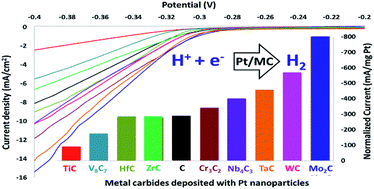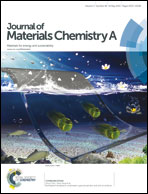Carbides of group IVA, VA and VIA transition metals as alternative HER and ORR catalysts and support materials†
Abstract
High surface area nano dimensional carbides of nine transition metals in group IV–VI have been synthesized using a salt flux method. Uniformity was maintained throughout the investigation, from synthesis method to electrochemical tests, so that a comparison can be made for the various carbides for their catalytic activities towards hydrogen evolution reaction (HER) and oxygen reduction reaction (ORR). Catalytic activities are dependent on synthesis method which determines the properties of the catalyst, and electrochemical conditions. Maintaining uniformity throughout the investigation allows for a more balanced comparison of a family of materials. Activity of all nine carbides show increased HER activity compared to bare glassy carbon working electrode. Mo2C, WC, and V8C7 show particularly enhanced HER activity. Similarly, Mo2C, Cr3C2, and V8C7 have significant ORR activities. Using a wet impregnation method, dispersed platinum nanoparticles ranging between 3 and 5 nm were successfully deposited on the carbides. The Pt deposited carbides have as much as three times higher HER activity and four times higher ORR activity compared to commercially available Pt/C catalyst, and show enhanced stability under fuel cell conditions.


 Please wait while we load your content...
Please wait while we load your content...